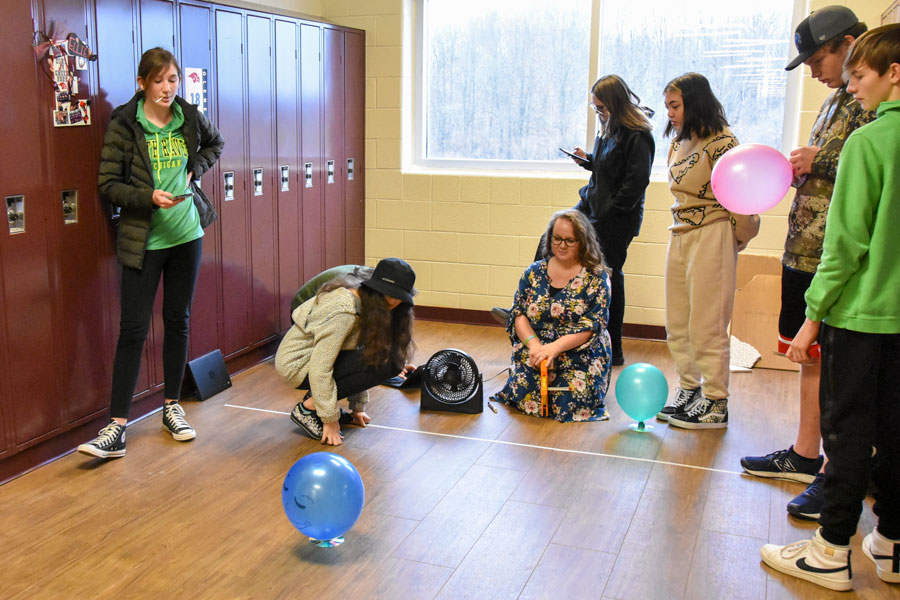Cedar Springs — As the leaf blower roared to life, Nikko Munoz clapped one hand over her mouth to stifle a small yelp of surprise and laughter. Within seconds, the contraption she was sitting on lifted off the ground and propelled Nikko across the tiled floor of the Cedar Springs High School lunchroom.
Her classmates clapped as she narrowly missed a stack of chairs and coasted to a stop near the other end of the room.
“It feels like a roller coaster,” Nikko exclaimed as she took a seat. “It felt super weird — that’s all I can describe it as. Just drifting across the entire room on a piece of wood and with a leaf blower next to you. So weird!”
Teacher Jordan Covey built the “hovercraft” as the second part of a two-step lab for her freshman conceptual physics class. The academic goal of the labs? That was to learn and understand Newton’s three laws of motion.
But actually putting students on plywood and gliding them across the room to demonstrate force, mass and acceleration? That was all Covey’s idea.
“My students mean more to me than just academics — it’s why I love teaching science,” said Covey. “I get to have fun with them, and they get to be messy and have a good time and make that connection between what they’re doing and what they’re learning.”
How the Law Works
In the first part of the lab, students created “mini hovercrafts” out of CDs, balloons, bottle lids and hot glue, and then sent them floating down the hallway. With a small fan creating an “air-hockey-table-effect” over the floor, the air escaping from the balloons and flowing under the CDs created a net force to get the device moving, Covey explained.
“Newton’s third law is about equal and opposite forces,” she said. “So as the air is pushing down, the floor is pushing back up and holding that air, and that’s what allows the movement.”
Teams of two competed to see whose hovercraft could travel the farthest down the hall, taking measurements to calculate the device’s velocity, acceleration, net force and momentum. Students were allowed to make adjustments to their hovercrafts, like increasing or decreasing the amount of mass — or air — in the balloons, to see how that would affect performance.
Taking a Surprise Ride
A few weeks later came the real test: After logging and analyzing data from their mini hovercrafts, the freshmen literally went for a ride on their very own hovercraft to compare how mass impacts movement.
Covey made the life-size version of the hovercraft using plywood, plastic wrap, duct tape and a leaf blower (thanks to a grant from the Cedar Springs Education Foundation). The concept, however, was the same: As the leaf blower pushed down into the plastic, the hovercraft lifted up and carried the student across the floor.
“I had no idea (Covey) would actually make a hovercraft that we would ride on,” Nikko said. “You could tell, like with (a classmate), he’s smaller than some of the other people who rode, and he went a lot faster. So you could tell that the greater the mass, the more time it would take to accelerate.”
‘Just drifting across the entire room on a piece of wood and with a leaf blower next to you. So weird!’
— student Nikko Munoz
Classmate Connor Hansen focused on the distance each hovercraft traveled in relation to its size and mass. Although his mini hovercraft had less weight and required less force to propel it down the hall, it traveled 47 feet. In comparison, the life-size hovercraft carrying him as a passenger was propelled by a much more forceful leaf blower, but only traveled 27 feet across the room.
Connor also took note of the time it took the devices to travel those distances.
“We’re trying to figure out the velocity, acceleration and force required to move each of them, so you need to have the mass, time and distance to find all of that,” he explained. “After that, it all kind of trickles down: You can find the velocity from its distance and time, with the velocity you can find its acceleration, and then with the acceleration you can measure the force.”
Definitely Not Boring
Connor said conceptual physics was his favorite class of the semester, and riding on a handmade hovercraft was just one reason why.
“If you don’t have fun while you’re learning, you’re not going to want to do it and it can be a struggle to get through the work sometimes,” Connor said. “Mrs. Covey pushes us, but she doesn’t really make anything boring. She gives us a decent amount of work, but she’s a fun teacher and I’m always interested to see what we’re going to do.”
Covey was a substitute teacher for 10 years before getting her own classroom at CSHS, “and I sat with a lot of students that were just tired of sitting at their desk,” she said. “I knew that I wanted that to change (in my own classroom), so I would do it myself.”
That meant going the extra mile for her conceptual physics students, spending evenings and even a part of the holiday break to build and test the equipment for the hovercraft labs.
But when students like Nikko are laughing over the absurdity of gliding along next to a leaf blower, Covey said, that’s a success.
“My goal is to have students hands-on and having fun, because that’s when they’re learning,” she said. “And then afterwards, if they’re like, ‘Dang it, she taught us so much and we had no idea,’ that’s what I love.”
















